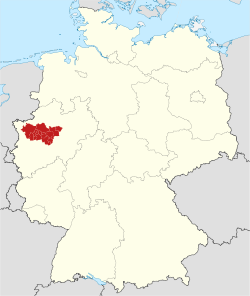Ruhr area
Ruhr Metropolitan Region
Metropolregion Ruhr | |
|---|---|
 map of the Ruhr metropolitan region within Germany | |
| Coordinates: 51°30′N 7°30′E / 51.500°N 7.500°E | |
| Country | |
| State | |
| Largest Cities | Dortmund Essen Duisburg Bochum |
| Government | |
| • Body | Regionalverband Ruhr |
| Area | |
| • Metro | 4,435 km2 (1,712 sq mi) |
| Highest elevation | 441 m (1,447 ft) |
| Lowest elevation | 13 m (43 ft) |
| Population | |
| • Metro | 5,172,745 |
| • Metro density | 1,646/km2 (4,260/sq mi) |
| Time zone | UTC+1 (CET) |
| GRP | 2007 |
| Nominal | € 136.3 billion[1] |
| Website | www.metropoleruhr.de |
The Ruhr Area (German: Ruhrgebiet) is an urban area in North Rhine-Westphalia, Germany. Many of the cities in the Ruhrgebiet used to have a lot of heavy industry.
The Ruhr Area is bordered by the rivers Ruhr River to the south, Rhine River to the west, and Lippe to the north. Southwest it borders the Bergisches Land.
The area has about 5.3 million inhabitants, and is part of the larger Rhine-Ruhr metropolitan area of more than 12 million people.
The Ruhr Area consists of the cities of Duisburg, Oberhausen, Bottrop, Mülheim an der Ruhr, Essen, Gelsenkirchen, Bochum, Herne, Hamm, Hagen and Dortmund and the rural districts of Wesel, Recklinghausen, Unna and Ennepe-Ruhr
Culture
The city of Essen in the Ruhr area was selected as European Capital of Culture for 2010 by the Council of the European Union.
Sources
- ↑ metropoleruhr.de
- ↑ highest: Wengeberg in Breckerfeld, lowest: Xanten
References
- Botting, Douglas (1985). From the Ruins of the Reich: Germany 1945–1949. New York: Crown Publishing. ISBN 0-517-55865-3.
- Bishop, Patrick. Bomber Boys Fighting Back 1940–1945
- French Directorate for Economic Affairs, Memorandum on the separation of the German industrial regions Archived 2011-08-09 at the Wayback Machine, 8 September 1945.
- Gareau, Frederick H. "Morgenthau's Plan for Industrial Disarmament in Germany", Western Political Quarterly, Vol. 14, No. 2 (Jun., 1961), pp. 517–53 in JSTOR
- Yoder, Amos. "The Ruhr Authority and the German Problem", Review of Politics, Vol. 17, No. 3 (Jul., 1955), pp. 345–358 in JSTOR
Further reading
- Kift, Roy, The Complete Ruhrgebiet: The English language guide (2018) (ISBN 978-3-8375-1876-4) Klartext Verlag, Essen [1] Archived 2022-05-22 at the Wayback Machine
- Berndt, Christian. Corporate Germany Between Globalization and Regional Place Dependence: Business Restructuring in the Ruhr Area (2001)
- Crew, David. Town in the Ruhr: A Social History of Bochum, 1860–1914 (1979) (ISBN 0231043007)
- Fischer, Conan. The Ruhr Crisis, 1923–1924 (2003)
- Gillingham, John. "Ruhr Coal Miners and Hitler's War", Journal of Social History Vol. 15, No. 4 (Summer, 1982), pp. 637–653 in JSTOR
- Chauncy D. Harris, "The Ruhr Coal-mining District", Geographical Review, 36 (1946), 194–221.
- Gillingham, John. Industry and Politics in the Third Reich: Ruhr Coal, Hitler, and Europe (1985) (ISBN 0231062605)
- Pounds, Norman J. G. The Ruhr: A Study in Historical and Economic Geography (1952) online Archived 2011-06-05 at the Wayback Machine
- Pierenkemper, Toni. "Entrepreneurs in Heavy Industry: Upper Silesia and the Westphalian Ruhr Region, 1852 to 1913", Business History Review Vol. 53, No. 1 (Spring, 1979), pp. 65–78 in JSTOR
- Royal Jae Schmidt. Versailles and the Ruhr: Seedbed of World War II (1968)
- Spencer, Elaine Glovka. "Employer Response to Unionism: Ruhr Coal Industrialists before 1914" Journal of Modern History Vol. 48, No. 3 (Sep., 1976), pp. 397–412 in JSTOR
- Spencer, Elaine Glovka. Management and Labor in Imperial Germany: Ruhr Industrialists as Employers, 1896–1914. Rutgers University Press. (1984) online Archived 2011-06-05 at the Wayback Machine
- Todd, Edmund N. "Industry, State, and Electrical Technology in the Ruhr Circa 1900", Osiris 2nd Series, Vol. 5, (1989), pp. 242–259 in JSTOR
Other websites
- Capital of Culture 2010 Official Site Archived 2012-09-19 at the Wayback Machine
- ruhr.2010 Capital of Culture Blog
- Ruhrgebietsbilder: Photos about the Ruhr Archived 2021-08-24 at the Wayback Machine